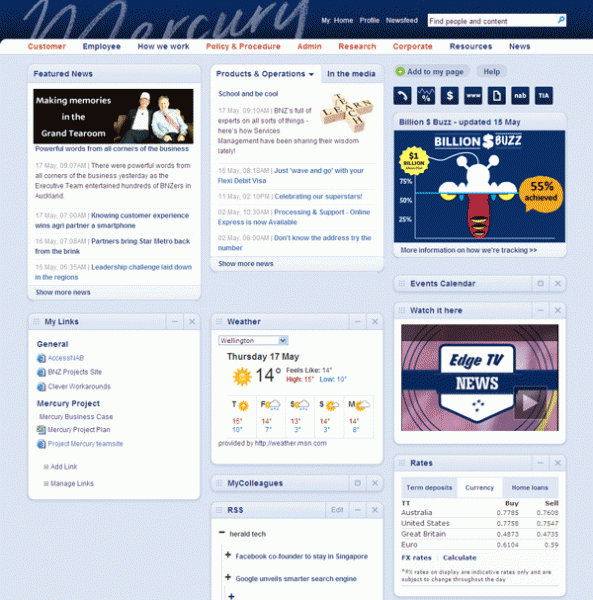Banking on a SharePoint intranet
A long term project to migrate to a SharePoint 2010 intranet at the Bank of New Zealand (BNZ) has required a major focus on the fundamentals of information management.
BNZ is one of the largest and oldest banks in New Zealand. Founded in 1861, BNZ operates 200 branches and has over 5000 employees. BNZ, which is a subsidiary of the National Australia Bank Group, also offers a full suite of insurance services and provides financial services to commercial and agricultural businesses.
Mick Gasson, Project Manager for BNZ, said, “We had to build some of the fundamental cornerstones of information architecture for this project, in order to implement an intranet based on metadata.”
The bank migrating to a new Sharepoint 2010 integrated intranet platform that its entire staff will turn to rather than seeing the intranet, Team Sites and document repositories as separate platforms.
The bank’s existing intranet was built in 2001 and now runs on an unsupported version of the Vignette web content management system (CMS). Lotus Notes is the BNZ email platform.
“The existing intranet has some publishing bottlenecks,” said Gasson.

“There are approximately nine authorised content publishers and an unwieldy interface to publish content to the intranet, so people instead publish content to their SharePoint Team Sites which become their sources of the truth.
“We also found a lot of documents being created as PDFs and published to the intranet as this was an easier process.
SharePoint has been widely deployed across the bank and there are now four different platforms in use.
“There are large numbers of Team Sites on 2007 that have become silos of information,” said Gasson.
The aim is to migrate all these platforms to SharePoint 2010 so that searching and finding information becomes easier. An initial pilot of a SharePoint 2007 mysites was rolled out in 2010 to 1000 users but was not widely adopted.
“It has been quite an evolutionary process. We started in Sharepoint 2007 and are now implementing in 2010. This is a large cultural change that has taken us a while to get right” said Gasson.
A new SharePoint 2010 portal page and news hub was launched in September 2011 developed in partnership with New Zealand SharePoint agency KnowledgeCue.
This provides BNZ staff with a customisable home page (MyHome pictured above) and news hub that acts as an entry point to the existing Vignette intranet, existing SP 2007 Team Sites and document repositories.
The MyHome page is able to be customised with individual Web parts maintained by separate business units, and incorporates a news feed provided via the Newsgator platform.
The news hub was selected as a “quick win” that could be easily implemented and provide a way for staff to become first acquainted with the SharePoint look and feel. The aim was to make it a more collaborative page and allow anybody across the organisation to contribute news.
Meanwhile the big job is still underway behind the scenes to migrate the existing Vignette intranet content into the new SP2010 intranet
“Policies,Procedures, Forms and Reference Material are being migrated into SharePoint 2010 catalogues and then we are surfacing that content onto the intranet pages using metadata and SharePoint search.”
The projects change management team has organised a large team of change champions devoted to communicating the changes across the bank, with champions appointed in each store.
One of the fundamental building blocks that had to be in place before the content migration was a structured corporate taxonomy.
To undertake this BNZ engaged a specialist consultant Trish O’Kane of Knoware.
The BNZ taxonomy is stored in application called Abacus. This feeds XML into another application called Layer 2 which publishes into the Term Store Management Tool in SharePoint 2010.
The end goal is to integrate navigation to individual Team Sites from the intranet and provide search across the whole enterprise.
Team Sites will host information and training material for individual business units, whereas the intranet will host resources meant for the entire enterprise.
“We tried to roll out enterprise search twice but there were problems with permissions in Team Sites that we are fixing by individually reviewing all of those sites,” said Gasson.
“We also need to communicate the message that enterprise search is a view of the information that individual staff members can actually see as opposed to their current understanding of search which is based on their experiences with Google.
To handle the large user population there is a SP 2010 farm environment on scalable virtual servers , and this is replicated four times to give separate development, testing and production environments and a failover.
(This article is based on a case study presented at the New Zealand SharePoint conference in Auckland)
